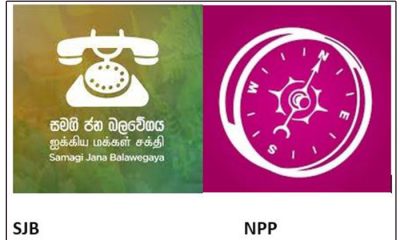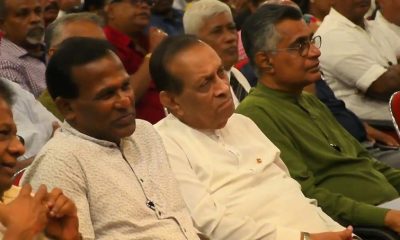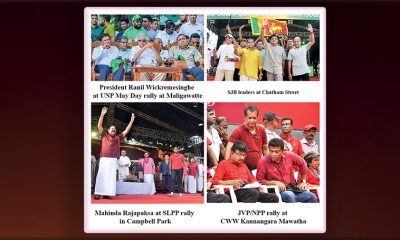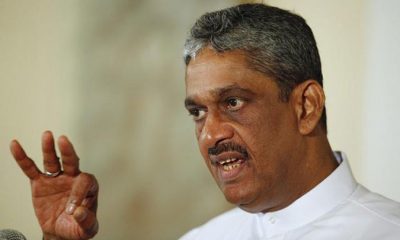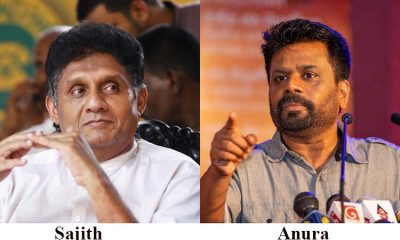Features
To be realistic, there are only two options

by Kumar David
There are only two political options (for want of a better word, though “trepidation” highlights another side of the matter) worth taking seriously – the President Ranil Wickremesinghe (RW) led outfit and the National Peoples’ Power (NPP) public face of the JVP. The RW-outfit may manifest itself in many forms such as a UNP-Sajith (SJB) alliance under some tactical leadership plan that may or may not include a Rajapaksa rascally rump. Whatever be their specific expositions, there are only two “camps” that matter up to and including the next election cycle. Let me call them the RW-outfit and the JVP-outfit – the Sinhala “kandavuru deka” captures the sense better. All other options (Champika, Sarath Fonseka, small left, and ethnic minority platforms) will have negligible electoral impact if they do not align with one of these big outfits. This is in respect of a presidential election; in parliamentary or provincial polls ethnic minority platforms will, of course, have a substantial impact in the areas of domicile of their communities.
It is necessary to state these encampment options prior to dealing with programmes and strategies. I will call the broad manner in which each camp presents itself to the people its National Strategy and this includes an ‘ideological orientation’, economic development plans, foreign trade priorities, and relationships with the IMF and ADB/IBRD to escape the stranglehold of debt. Approaches will need to be formulated by each side for state-owned enterprises. Foreign policy, especially in respect of India and the US is absolutely crucial. When I say ‘ideological orientation’ I am referring to democracy, militarisation, curbing Sinhala-Buddhist excesses and the democratisation of state-power. All this is a big canvas and strategists, planners and scholars will contribute to this discourse in the next 12 months. I will only make a simple start here; not in any particular order.
RW is a capitalist-roader in the sense that he subscribes to the view that “by letting market-forces run their course, to enhance their own gain capitalists, will as though by an invisible hand, promote the public good”. (Adapted from Adam Smith’s ‘Theory of Moral Sentiments”). Faith in the free-market with minimal state intervention is gospel among modern bourgeois ideologues and that RW belongs here is no surprise. Unconstrained by other pressures, this is where RW will lead the nation as JR did and Felix tried. However, I refrain from calling RW a neo-liberal (neo-conservative extremist) despite his penchant for using the military to subdue political dissent because he is influenced by liberal intellectuals in his personal and political entourage. The obscenity of outright dictatorship is best practised by Generals (gorillas); vide Chile, Pakistan, Argentina, Burma, and Indonesia and so on and so on. A military regime in Sri Lanka will not fail to string-up RW alongside the left, the intelligentsia, the liberals and the feckless Fourth Estate. Having said this it is frightening to observe that Netanyahu and his simple majority in Parliament are driving Israel (of all countries) in a neo-fascist direction less than 70 years after the fall of Nazism. I will deal with extremism and global threats to liberal values in my next essay in September – I intend to write less than weekly from now on.
The other camp, the JVP/NPP; how shall we designate it? It is not Stalinist in the sense that it harks to the discredited Soviet-style all-embracing central plan, it no longer subscribes to any variant of Maoist dementia (Cultural Revolution); it acknowledges that 1971 and 1989-90 were wild excesses unrelated to real world possibilities. This is what the JVP now is not; but what IS it? It, itself doesn’t know yet, but the demands of approaching electoral challenges will force the JVP/NPP to define and declare its programme; to define its ideology, to publish an economic programme and to declare what it proposes to do about pesky minorities and pestilential Sinhala-Buddhism.
Allow me to move to a few economic topics. It’s a no brainer that exports need to be an engine of growth. There is a huge amount of experience in other developing countries (Korea, Mexico and South Africa to quote at random from three continents) and indeed in Sri Lanka in the past before Rajapaksa era sleaze snuffed it out. Both the private sector and government agencies were coordinated in the past and this needs to be revived. It may already be on the move behind the scene, but why behind the scene? Participants, product lines (industrial, fruit, marine products etc.), benefit from agreements between countries and future plans should be made explicit. If we intend to give the invisible hand a leg up (sorry, bad pun) let us make it more visible. Neither the RW-camp nor the JVP-camp have published or made their proposals explicit.
Moribund state-owned enterprises need an action plan and this is likely to be contentious between the two camps. There are rotting corpses like Sri Lankan Airlines that it is universally agreed must be cremated. Mahinda’s recklessness and Gota’s witlessness have brought it to the crematorium and the point now is quick disposal. But there are other cases which are complicated, the CEB for example. The government, for social and political reasons, offers electricity at heavily subsidised prices to low income households. The burden has to be borne by the CEB which does not receive corresponding compensation on imported fuel costs (coal, furnace oil and diesel). Therefore, on the books it appears that the CEB is a huge loss making enterprise but this impression is incorrect. This ambiguity is true though to a lesser extent in the petroleum corporation and the railways. A distinction has to be made between culling white elephants like Sri Lankan Airlines and other state-owned enterprises for each of which separate plans must be prepared.
A crucial matter for heavily indebted countries like Sri Lanka is debt restructuring. I will summarise a Reuters report datelined June 2023 about a deal to restructure debt owed by Zambia to other governments and private creditors around the world. The biggest slab, $6.3 billion owed to China’s Export-Import Bank, underlines the importance of Beijing’s agreement to support the plan. The agreement calls for Zambia’s debt to be rescheduled over 20 years with a three-year grace period during which only interest payments will be made. Private creditors too are expected to likewise restructure the $6.8 billion owed to them. The exercise is viewed by the Group of 20 wealthy nations as a test case. I will make no further comment but ask whether the RW-side or the JVP-side is actively following up the Zambian example
The most significant advantage of the Zambian plan will be a sharp recovery of the value of the Kwacha against international currencies. This will impact prices of imported goods and domestic production. Here in Sri Lanka prices of essential goods and inflation are driving the poor and the middle-classes to desperation. The one matter about which every political actor agrees is prices of food and essentials (medicines, cooking fuel, school uniforms and so on) must be addressed. A debt restructuring programme supported by the IMF and other multilateral agencies is essential. Is it unrealistic to imagine the value of the LKR appreciating to 200 to 250 to the US dollar within a year?
The government (Central Bank and Treasury) from all reports is in thick of it. The RW-camp therefore is involved, but I doubt if JVP/NPP policy makers are giving their minds to these concerns. Since the JVP/NPP is a contender for state power there will be persons of intellectual ability and professional experience who will be willing to cooperate, but the trouble is that it is foolishly dragging its feet.
There are several such policy matters deserving a short discussion in a draft programme. For example a new constitution, inflation targeting, price control of essentials, state-owned enterprises, sovereign wealth funds, and energy policy. I will devote the rest of this essay to energy pricing and policy because a draft programme for the electricity sector is before parliament right now.
The Ceylon Electricity Board is called a huge loss-making enterprise. How fair is that allegation? For social and political reasons the government provides low income households with heavily subsidised electricity. The average generation price is far higher. If the government hands out electricity to low income households at X rupees per kWh but the average generating (net of cross subsidy from affluent customer) is say Y rupees (average generation costs depends on coal, fuel oil and diesel prices), and if the energy so handed out is Z billion kWh per year, the CEB will unavoidably incur a “loss” of (Y-X)*Z billion rupees annually. If Y is 20, X is 5 and Z is 20, it will appear that the CEB is a public sector enterprise “losing” Rs350 billion per annum. This of course is bollocks! Will the energy ministry make available a detailed breakdown of X, Y and Z? Given the data a child can do the calculations on the back of a postage stamp.
The term that echoes across the government’s thought processes is “privatisation”; anything that moves or breathes, grab it, privatise it. While there is a case for handing over some failing state enterprises to private management, the experts on the government’s lobby have little knowledge of the concept of Public Goods. There are some things which by their intrinsic nature belong to the public domain, to the people; scenic beauty, forests, the courts of law, the military, the police, a nation’s communications backbone and the transmission grid and system control infrastructure. The concept of Public Goods has not been discussed or understood in Sri Lanka or for that matter in many countries.
A related matter pertains to privatisation of the electricity distribution systems which like the transmission backbone and system control facilities should remain under public ownership. In the UK for example where the distribution system was privatised, terrible complications have arisen. Once a private owner acquires control it has the right to sell onward into markets where it is chopped, spliced with bits and pieces of other financial assets and sold onward into a maze. Since the financial crisis of 2008 these instruments called ‘derivatives’, and other speculative and ‘leveraged’ financial products have become prominent and it is no longer easy to say where ownership lies. In simple words if we privatise into this fog it’s a maze where ownership of our distribution assets is murky with loss of control and inability to repossess. In the UK, chasing up who owns the now privatised one-time Regional Distribution utilities has become a nightmare.
I need to bring this discussion of electricity sector options into line with my opening theme that there are only two realistic political options – liberalism and the left. True RW liberalism bears the blemish of potential military excesses and the JVP is haunted by its rebellious past. Nevertheless the public and trade unions will be increasingly enthused by the upcoming elections than by these theoretical abstractions as the months pass; let’s wait and see how things pan out in the months ahead.
The privatisation of the Central Electricity Generating Board (CEGB) has turned out to be another of that Thatcher woman’s ideologically driven blunders to rival her privatisation of British Rail. Throughout Europe the railways are state-owned and excellent. Western Europe’s SNCF, Deutsche Bahn, Trenitalia, as well as the networks in Eastern Europe are state-owned. It is in the UK alone that that Thatcher woman careened from Hayek driven blunder to blunder. In Lanka Privatisation seems to be the government and Minister Kanchana Wijesekera’s buzzword; so it seems Lanka is treading the same road? In context, I also do wish people would stop talking about renewable energy projects solar and wind in MW (power) and deal in expected annual MW-hours (energy). What’s the use of a 1000 horse power -Ferrari in your garage if your fuel tank is empty?
To tie up these threads to my opening theme, the government hopes that people are so fed up with the CEB and presumed CEB corruption that it believes there will be overwhelming support for privatisation. That may be incorrect. When all the facts as I have outlined here come into focus in the public mind, I believe that support for privatisation of public goods such as the CEB’s key assets, the telecommunications backbone and the petroleum industry will evaporate.
Features
The heart-friendly health minister

by Dr Gotabhya Ranasinghe
Senior Consultant Cardiologist
National Hospital Sri Lanka
When we sought a meeting with Hon Dr. Ramesh Pathirana, Minister of Health, he graciously cleared his busy schedule to accommodate us. Renowned for his attentive listening and deep understanding, Minister Pathirana is dedicated to advancing the health sector. His openness and transparency exemplify the qualities of an exemplary politician and minister.
Dr. Palitha Mahipala, the current Health Secretary, demonstrates both commendable enthusiasm and unwavering support. This combination of attributes makes him a highly compatible colleague for the esteemed Minister of Health.
Our discussion centered on a project that has been in the works for the past 30 years, one that no other minister had managed to advance.
Minister Pathirana, however, recognized the project’s significance and its potential to revolutionize care for heart patients.
The project involves the construction of a state-of-the-art facility at the premises of the National Hospital Colombo. The project’s location within the premises of the National Hospital underscores its importance and relevance to the healthcare infrastructure of the nation.
This facility will include a cardiology building and a tertiary care center, equipped with the latest technology to handle and treat all types of heart-related conditions and surgeries.
Securing funding was a major milestone for this initiative. Minister Pathirana successfully obtained approval for a $40 billion loan from the Asian Development Bank. With the funding in place, the foundation stone is scheduled to be laid in September this year, and construction will begin in January 2025.
This project guarantees a consistent and uninterrupted supply of stents and related medications for heart patients. As a result, patients will have timely access to essential medical supplies during their treatment and recovery. By securing these critical resources, the project aims to enhance patient outcomes, minimize treatment delays, and maintain the highest standards of cardiac care.
Upon its fruition, this monumental building will serve as a beacon of hope and healing, symbolizing the unwavering dedication to improving patient outcomes and fostering a healthier society.We anticipate a future marked by significant progress and positive outcomes in Sri Lanka’s cardiovascular treatment landscape within the foreseeable timeframe.
Features
A LOVING TRIBUTE TO JESUIT FR. ALOYSIUS PIERIS ON HIS 90th BIRTHDAY

by Fr. Emmanuel Fernando, OMI
Jesuit Fr. Aloysius Pieris (affectionately called Fr. Aloy) celebrated his 90th birthday on April 9, 2024 and I, as the editor of our Oblate Journal, THE MISSIONARY OBLATE had gone to press by that time. Immediately I decided to publish an article, appreciating the untiring selfless services he continues to offer for inter-Faith dialogue, the renewal of the Catholic Church, his concern for the poor and the suffering Sri Lankan masses and to me, the present writer.
It was in 1988, when I was appointed Director of the Oblate Scholastics at Ampitiya by the then Oblate Provincial Fr. Anselm Silva, that I came to know Fr. Aloy more closely. Knowing well his expertise in matters spiritual, theological, Indological and pastoral, and with the collaborative spirit of my companion-formators, our Oblate Scholastics were sent to Tulana, the Research and Encounter Centre, Kelaniya, of which he is the Founder-Director, for ‘exposure-programmes’ on matters spiritual, biblical, theological and pastoral. Some of these dimensions according to my view and that of my companion-formators, were not available at the National Seminary, Ampitiya.
Ever since that time, our Oblate formators/ accompaniers at the Oblate Scholasticate, Ampitiya , have continued to send our Oblate Scholastics to Tulana Centre for deepening their insights and convictions regarding matters needed to serve the people in today’s context. Fr. Aloy also had tried very enthusiastically with the Oblate team headed by Frs. Oswald Firth and Clement Waidyasekara to begin a Theologate, directed by the Religious Congregations in Sri Lanka, for the contextual formation/ accompaniment of their members. It should very well be a desired goal of the Leaders / Provincials of the Religious Congregations.
Besides being a formator/accompanier at the Oblate Scholasticate, I was entrusted also with the task of editing and publishing our Oblate journal, ‘The Missionary Oblate’. To maintain the quality of the journal I continue to depend on Fr. Aloy for his thought-provoking and stimulating articles on Biblical Spirituality, Biblical Theology and Ecclesiology. I am very grateful to him for his generous assistance. Of late, his writings on renewal of the Church, initiated by Pope St. John XX111 and continued by Pope Francis through the Synodal path, published in our Oblate journal, enable our readers to focus their attention also on the needed renewal in the Catholic Church in Sri Lanka. Fr. Aloy appreciated very much the Synodal path adopted by the Jesuit Pope Francis for the renewal of the Church, rooted very much on prayerful discernment. In my Religious and presbyteral life, Fr.Aloy continues to be my spiritual animator / guide and ongoing formator / acccompanier.
Fr. Aloysius Pieris, BA Hons (Lond), LPh (SHC, India), STL (PFT, Naples), PhD (SLU/VC), ThD (Tilburg), D.Ltt (KU), has been one of the eminent Asian theologians well recognized internationally and one who has lectured and held visiting chairs in many universities both in the West and in the East. Many members of Religious Congregations from Asian countries have benefited from his lectures and guidance in the East Asian Pastoral Institute (EAPI) in Manila, Philippines. He had been a Theologian consulted by the Federation of Asian Bishops’ Conferences for many years. During his professorship at the Gregorian University in Rome, he was called to be a member of a special group of advisers on other religions consulted by Pope Paul VI.
Fr. Aloy is the author of more than 30 books and well over 500 Research Papers. Some of his books and articles have been translated and published in several countries. Among those books, one can find the following: 1) The Genesis of an Asian Theology of Liberation (An Autobiographical Excursus on the Art of Theologising in Asia, 2) An Asian Theology of Liberation, 3) Providential Timeliness of Vatican 11 (a long-overdue halt to a scandalous millennium, 4) Give Vatican 11 a chance, 5) Leadership in the Church, 6) Relishing our faith in working for justice (Themes for study and discussion), 7) A Message meant mainly, not exclusively for Jesuits (Background information necessary for helping Francis renew the Church), 8) Lent in Lanka (Reflections and Resolutions, 9) Love meets wisdom (A Christian Experience of Buddhism, 10) Fire and Water 11) God’s Reign for God’s poor, 12) Our Unhiddden Agenda (How we Jesuits work, pray and form our men). He is also the Editor of two journals, Vagdevi, Journal of Religious Reflection and Dialogue, New Series.
Fr. Aloy has a BA in Pali and Sanskrit from the University of London and a Ph.D in Buddhist Philosophy from the University of Sri Lankan, Vidyodaya Campus. On Nov. 23, 2019, he was awarded the prestigious honorary Doctorate of Literature (D.Litt) by the Chancellor of the University of Kelaniya, the Most Venerable Welamitiyawe Dharmakirthi Sri Kusala Dhamma Thera.
Fr. Aloy continues to be a promoter of Gospel values and virtues. Justice as a constitutive dimension of love and social concern for the downtrodden masses are very much noted in his life and work. He had very much appreciated the commitment of the late Fr. Joseph (Joe) Fernando, the National Director of the Social and Economic Centre (SEDEC) for the poor.
In Sri Lanka, a few religious Congregations – the Good Shepherd Sisters, the Christian Brothers, the Marist Brothers and the Oblates – have invited him to animate their members especially during their Provincial Congresses, Chapters and International Conferences. The mainline Christian Churches also have sought his advice and followed his seminars. I, for one, regret very much, that the Sri Lankan authorities of the Catholic Church –today’s Hierarchy—- have not sought Fr.
Aloy’s expertise for the renewal of the Catholic Church in Sri Lanka and thus have not benefited from the immense store of wisdom and insight that he can offer to our local Church while the Sri Lankan bishops who governed the Catholic church in the immediate aftermath of the Second Vatican Council (Edmund Fernando OMI, Anthony de Saram, Leo Nanayakkara OSB, Frank Marcus Fernando, Paul Perera,) visited him and consulted him on many matters. Among the Tamil Bishops, Bishop Rayappu Joseph was keeping close contact with him and Bishop J. Deogupillai hosted him and his team visiting him after the horrible Black July massacre of Tamils.
Features
A fairy tale, success or debacle

Sri Lanka-Singapore Free Trade Agreement
By Gomi Senadhira
senadhiragomi@gmail.com
“You might tell fairy tales, but the progress of a country cannot be achieved through such narratives. A country cannot be developed by making false promises. The country moved backward because of the electoral promises made by political parties throughout time. We have witnessed that the ultimate result of this is the country becoming bankrupt. Unfortunately, many segments of the population have not come to realize this yet.” – President Ranil Wickremesinghe, 2024 Budget speech
Any Sri Lankan would agree with the above words of President Wickremesinghe on the false promises our politicians and officials make and the fairy tales they narrate which bankrupted this country. So, to understand this, let’s look at one such fairy tale with lots of false promises; Ranil Wickremesinghe’s greatest achievement in the area of international trade and investment promotion during the Yahapalana period, Sri Lanka-Singapore Free Trade Agreement (SLSFTA).
It is appropriate and timely to do it now as Finance Minister Wickremesinghe has just presented to parliament a bill on the National Policy on Economic Transformation which includes the establishment of an Office for International Trade and the Sri Lanka Institute of Economics and International Trade.
Was SLSFTA a “Cleverly negotiated Free Trade Agreement” as stated by the (former) Minister of Development Strategies and International Trade Malik Samarawickrama during the Parliamentary Debate on the SLSFTA in July 2018, or a colossal blunder covered up with lies, false promises, and fairy tales? After SLSFTA was signed there were a number of fairy tales published on this agreement by the Ministry of Development Strategies and International, Institute of Policy Studies, and others.
However, for this article, I would like to limit my comments to the speech by Minister Samarawickrama during the Parliamentary Debate, and the two most important areas in the agreement which were covered up with lies, fairy tales, and false promises, namely: revenue loss for Sri Lanka and Investment from Singapore. On the other important area, “Waste products dumping” I do not want to comment here as I have written extensively on the issue.
1. The revenue loss
During the Parliamentary Debate in July 2018, Minister Samarawickrama stated “…. let me reiterate that this FTA with Singapore has been very cleverly negotiated by us…. The liberalisation programme under this FTA has been carefully designed to have the least impact on domestic industry and revenue collection. We have included all revenue sensitive items in the negative list of items which will not be subject to removal of tariff. Therefore, 97.8% revenue from Customs duty is protected. Our tariff liberalisation will take place over a period of 12-15 years! In fact, the revenue earned through tariffs on goods imported from Singapore last year was Rs. 35 billion.
The revenue loss for over the next 15 years due to the FTA is only Rs. 733 million– which when annualised, on average, is just Rs. 51 million. That is just 0.14% per year! So anyone who claims the Singapore FTA causes revenue loss to the Government cannot do basic arithmetic! Mr. Speaker, in conclusion, I call on my fellow members of this House – don’t mislead the public with baseless criticism that is not grounded in facts. Don’t look at petty politics and use these issues for your own political survival.”
I was surprised to read the minister’s speech because an article published in January 2018 in “The Straits Times“, based on information released by the Singaporean Negotiators stated, “…. With the FTA, tariff savings for Singapore exports are estimated to hit $10 million annually“.
As the annual tariff savings (that is the revenue loss for Sri Lanka) calculated by the Singaporean Negotiators, Singaporean $ 10 million (Sri Lankan rupees 1,200 million in 2018) was way above the rupees’ 733 million revenue loss for 15 years estimated by the Sri Lankan negotiators, it was clear to any observer that one of the parties to the agreement had not done the basic arithmetic!
Six years later, according to a report published by “The Morning” newspaper, speaking at the Committee on Public Finance (COPF) on 7th May 2024, Mr Samarawickrama’s chief trade negotiator K.J. Weerasinghehad had admitted “…. that forecasted revenue loss for the Government of Sri Lanka through the Singapore FTA is Rs. 450 million in 2023 and Rs. 1.3 billion in 2024.”
If these numbers are correct, as tariff liberalisation under the SLSFTA has just started, we will pass Rs 2 billion very soon. Then, the question is how Sri Lanka’s trade negotiators made such a colossal blunder. Didn’t they do their basic arithmetic? If they didn’t know how to do basic arithmetic they should have at least done their basic readings. For example, the headline of the article published in The Straits Times in January 2018 was “Singapore, Sri Lanka sign FTA, annual savings of $10m expected”.
Anyway, as Sri Lanka’s chief negotiator reiterated at the COPF meeting that “…. since 99% of the tariffs in Singapore have zero rates of duty, Sri Lanka has agreed on 80% tariff liberalisation over a period of 15 years while expecting Singapore investments to address the imbalance in trade,” let’s turn towards investment.
Investment from Singapore
In July 2018, speaking during the Parliamentary Debate on the FTA this is what Minister Malik Samarawickrama stated on investment from Singapore, “Already, thanks to this FTA, in just the past two-and-a-half months since the agreement came into effect we have received a proposal from Singapore for investment amounting to $ 14.8 billion in an oil refinery for export of petroleum products. In addition, we have proposals for a steel manufacturing plant for exports ($ 1 billion investment), flour milling plant ($ 50 million), sugar refinery ($ 200 million). This adds up to more than $ 16.05 billion in the pipeline on these projects alone.
And all of these projects will create thousands of more jobs for our people. In principle approval has already been granted by the BOI and the investors are awaiting the release of land the environmental approvals to commence the project.
I request the Opposition and those with vested interests to change their narrow-minded thinking and join us to develop our country. We must always look at what is best for the whole community, not just the few who may oppose. We owe it to our people to courageously take decisions that will change their lives for the better.”
According to the media report I quoted earlier, speaking at the Committee on Public Finance (COPF) Chief Negotiator Weerasinghe has admitted that Sri Lanka was not happy with overall Singapore investments that have come in the past few years in return for the trade liberalisation under the Singapore-Sri Lanka Free Trade Agreement. He has added that between 2021 and 2023 the total investment from Singapore had been around $162 million!
What happened to those projects worth $16 billion negotiated, thanks to the SLSFTA, in just the two-and-a-half months after the agreement came into effect and approved by the BOI? I do not know about the steel manufacturing plant for exports ($ 1 billion investment), flour milling plant ($ 50 million) and sugar refinery ($ 200 million).
However, story of the multibillion-dollar investment in the Petroleum Refinery unfolded in a manner that would qualify it as the best fairy tale with false promises presented by our politicians and the officials, prior to 2019 elections.
Though many Sri Lankans got to know, through the media which repeatedly highlighted a plethora of issues surrounding the project and the questionable credentials of the Singaporean investor, the construction work on the Mirrijiwela Oil Refinery along with the cement factory began on the24th of March 2019 with a bang and Minister Ranil Wickremesinghe and his ministers along with the foreign and local dignitaries laid the foundation stones.
That was few months before the 2019 Presidential elections. Inaugurating the construction work Prime Minister Ranil Wickremesinghe said the projects will create thousands of job opportunities in the area and surrounding districts.
The oil refinery, which was to be built over 200 acres of land, with the capacity to refine 200,000 barrels of crude oil per day, was to generate US$7 billion of exports and create 1,500 direct and 3,000 indirect jobs. The construction of the refinery was to be completed in 44 months. Four years later, in August 2023 the Cabinet of Ministers approved the proposal presented by President Ranil Wickremesinghe to cancel the agreement with the investors of the refinery as the project has not been implemented! Can they explain to the country how much money was wasted to produce that fairy tale?
It is obvious that the President, ministers, and officials had made huge blunders and had deliberately misled the public and the parliament on the revenue loss and potential investment from SLSFTA with fairy tales and false promises.
As the president himself said, a country cannot be developed by making false promises or with fairy tales and these false promises and fairy tales had bankrupted the country. “Unfortunately, many segments of the population have not come to realize this yet”.
(The writer, a specialist and an activist on trade and development issues . )




